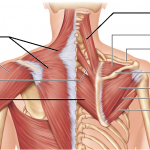Shoulder Pain and Injury Exercise -Trigger Point Releases with the Pocket Physio
Shoulder Pain and Injury Exercise -Trigger Point Releases with the Pocket Physio
This is a terrific home exercise for patients suffering from shoulder pain.
There are many causes of shoulder pain including:
- Rotator cuff tendon pathology (tears partial or full thickness)
- Subacromial bursitis
- pathology of the long head of biceps
- acromial-clavicular joint injuries (AC joint)
- osteoarthritis
- sports injuries (including shoulder impingement)
- …and many more conditions
One of the common contributing factors to any shoulder pain is tightness ‘behind the shoulder’. This region is known as the rotator cuff interval or the posterior capsule.
The effect of having tight structures at the back of the shoulder is that this tightness will in effect push (or shear)the humeral head (arm bone) forwards. This forward migration of the humeral head effectively means that the shoulder is no longer ‘sitting well’. In common parlance, the ball (of the ball and socket shoulder joint) is sitting slightly off centre from the ‘socket’ (the glenoid fossa of the scapula).
Using the POCKET PHYSIO or a similar self-massage device as demonstrated in this video is a terrific home exercise that will aid in reducing the ‘load’ or pressure that the shoulder experiences.
This self-trigger exercise will reduce the tightness or tension in the rotator cuff/capsule allowing for the humeral head (or ball of the socket) to sit in a more favourable position than what it was before the tightness at the back of the shoulder was released.
When using the Pocket Physio be sure to:
- put the point up
- keep your arm that you are releasing at 90degs
- spend 1-3mins on each side
- gently drop your body weight into the Pocket Physio, hold until you feel the trigger release. Then repeat on the next trigger point or place where you feel the tension.
- Use your discretion with how much pressure you put into your shoulder. You cannot cause any damage however you also do not want to bruise yourself!
This exercise is good for not only patients already suffering shoulder pain but also upper limb athletes such as tennis players and swimmers in terms of preventing potential shoulder injuries and maximising the function of the shoulder.
Feel free to leave any comments or questions that you may have.







